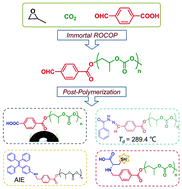Aldehyde end-capped CO2-based polycarbonates: a green synthetic platform for site-specific functionalization†
Abstract
Aldehyde end-capped polymers are unique for their quantitative functionalization degree, and are useful in drug delivery, diagnosis and surface modification. However, relevant research studies have mainly focused on polyolefins as main materials, whose non-biodegradable characters may impede their further applications. To address this issue, we developed a strategy to synthesize aldehyde end-capped CO2-based polycarbonates, namely the copolymerization of propylene epoxide and CO2 in the presence of 4-formylbenzoic acid as the chain transfer agent. Well-defined polycarbonates were obtained with controllable Mn in the range of 3.7–19.0 kg mol−1 and Đ of ∼1.1. The high reactivity aldehyde end groups of polymers permit further post-polymerization. As a proof-of-concept, several typical post-polymerization reactions were performed to diversify functionalities, including regulating hydrophilicity, changing thermal properties, and causing aggregation-induced emission and amino acid conjugation, which suggested the potential of aldehyde end-capped polycarbonates as a green platform to prepare functional materials.

- This article is part of the themed collection: Polymer Chemistry Emerging Investigators Series


 Please wait while we load your content...
Please wait while we load your content...